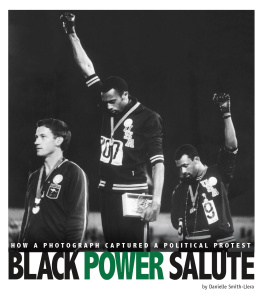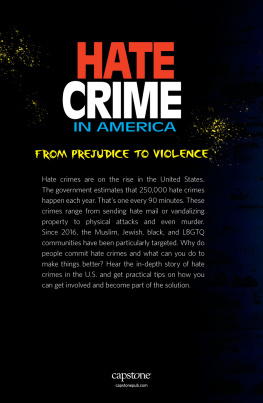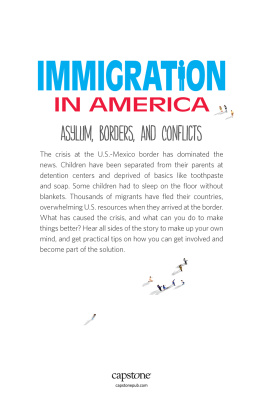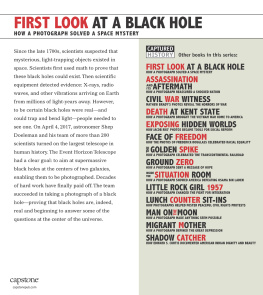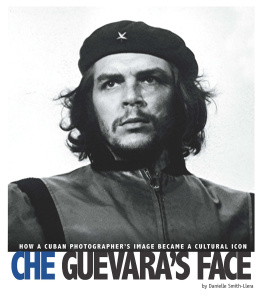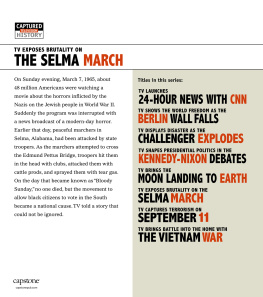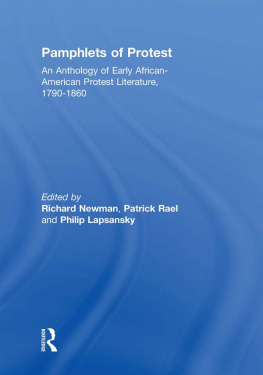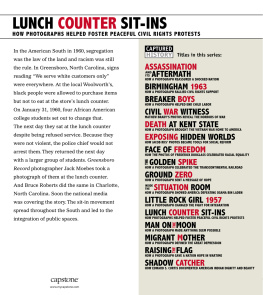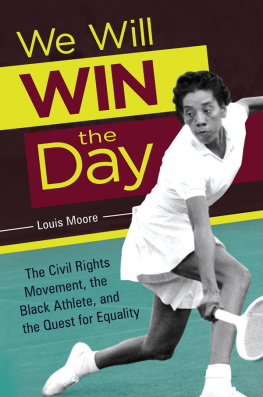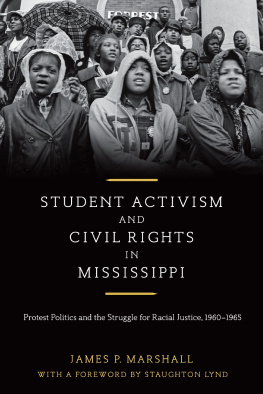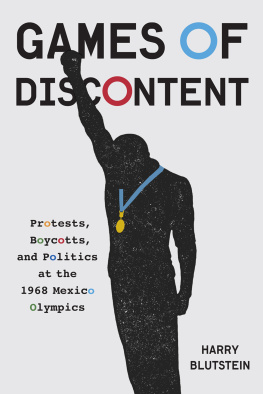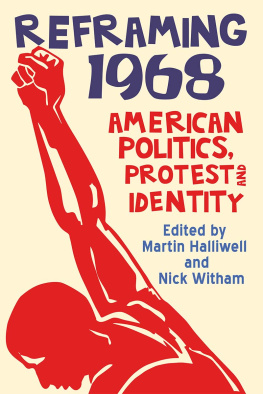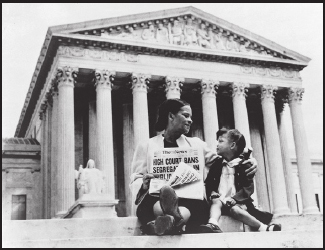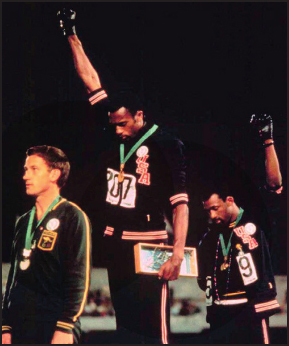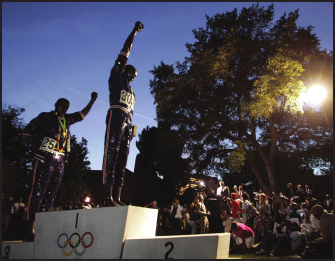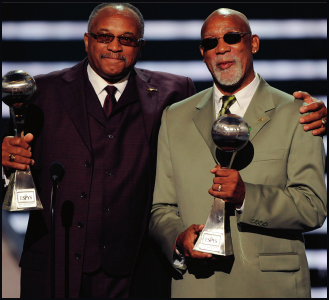Timeline
June 6, 1944 Tommie Smith is born in Clarksville, Texas |
June 5, 1945 John Carlos is born in Harlem, New York City |
May 1954 In Brown v. Board of Education, the Supreme Court rules that separate is not equal and that segregation in public schools is unconstitutional | |
1967 The Olympic Project for Human Rights is formed |
April 4, 1968 Martin Luther King Jr. is assassinated in Memphis, Tennessee; riots erupt in many U.S. cities |
1964 President Lyndon Johnson signs the Civil Rights Act of 1964, which outlaws segregation |
1965 Johnson pushes the Voting Rights Act through Congress, allowing millions of African-Americans to vote for the first time | |
October 17, 1968 Smith wins gold, Peter Norman wins silver, and Carlos wins bronze in the 200-meter sprint at the Mexico City Olympics; Smith and Carlos raise black-gloved fists during the national anthem | |
1969 Smith graduates from San Jose State and plays professional football for three years; he later earns a masters degree; Carlos helps lead San Jose State to its first national championship with wins in two sprints and a relay |
1970 Carlos graduates from San Jose State and plays professional football for a short time |
1972 Smith becomes track coach at Oberlin College and teaches in the sociology department; he then spends 27 years as coach and professor at Santa Monica College until retiring in 2005 |
1978 Smith is inducted into the National Track and Field Hall of Fame |
1984 Carlos works with the U.S. Olympic Committee in Los Angeles |
2005 Smith and Carlos receive honorary doctorates from San Jose State University; they attend the dedication of a campus statue honoring their Olympic salute | |
2006 Peter Norman dies in Melbourne, Australia; Smith and Carlos serve as pallbearers |
1985 Carlos becomes a track and field coach and guidance counselor at Palm Springs High School in California, where he works until retirement |
2003 Carlos is inducted into the National Track and Field Hall of Fame |
2008 Smith and Carlos are awarded the Arthur Ashe Award for Courage | |
2016 Smith and Carlos are named Olympic ambassadors; President Barack Obama honors them at the White House |
Glossary
person who works for social or political changeapartheidformer policy of racial segregation and discrimination in South Africato refuse as a group to take part in something as a protestrights that all Americans have to freedom and equal treatment under the lawunfair treatment of people, often because of race, religion, gender, sexual preference, or ageintegrationpractice of allowing people of all races to attend public schools and enter other public placesneedless killing of a group of helpless peoplepropagandainformation spread to try to influence the thinking of people; often not completely true or fairpractice of separating people of different races, income classes, or ethnic groupsfarmer who works land owned by someone else in exchange for housing and part of the profitslaw or action that conflicts with the Constitution, the document that set up the government of the United States
Additional Resources
Further Reading
- Herman, Gail. What Are the Summer Olympics? New York: Grosset & Dunlap, 2016.
- Nardo, Don. Massacre in Munich: How Terrorists Changed the Olympics and the World. North Mankato, Minn.: Compass Point Books, 2016.
- Tarrant-Reid, Linda. Discovering Black America: From the Age of Exploration to the Twenty-First Century. NewYork: Abrams Books for Young Readers, 2012.
Critical Thinking Using the Common Core
How did the reaction of athletes to Jesse Owens visit during the 1968 Olympics demonstrate the difference in attitude of activists in the 1960s and that of a generation earlier? (Key Ideas and Details)
Why was the San Jose State community an ideal place for activism to arise in the late 1960s? Consider specific people who were responsible. Also consider what conditions motivated them to organize. (Integration of Knowledge and Ideas)
Why do you think John Dominis photo was once considered a portrait of unpatriotic Americans and decades later is considered a portrait of heroes? (Integration of Knowledge and Ideas)
Source Notes
- Ibid.
- Black Power Salute.
- Black Power Salute.
- A Stubborn Protest Jars the Games: Amid Gold Medals, Raised Black Fists. Life. 1 Nov. 1968, p. 64C.
- I Have a Dream
- Stokely Carmichael, Rights Leader Who Coined Black Power, Dies at 57.
- Ibid.
- Malcolm X. Make It Plain.
- Joseph M. Sheehan. 2 Black Power Advocates Ousted From Olympics.The New York Times. 19 Oct. 1968, pp. 1 and 45.
- Ibid
- The explosive 1968 Olympics.
- 1968: Black athletes make silent protest.
- The explosive 1968 Olympics.
- Black Power Salute.
- The explosive 1968 Olympics.
- Black Power Salute.
- The explosive 1968 Olympics.
- Ibid.
- Ibid.
- Black Power Salute.
- Ibid.
- The explosive 1968 Olympics.
- Black Power Salute.
- The explosive 1968 Olympics.
- Ibid.
- Ibid
- 50 stunning Olympic moments No. 13: Tommie Smith and John Carlos salute.
- John Dominis, a Star Photographer for Life Magazine, Dies at 92.
- Ibid.
- 47 Years Ago, Olympian John Carlos Raised His Fist for Equality.
- The Black Power Salute That Rocked the 1968 Olympics.
- The explosive 1968 Olympics.
- Black Power Salute.
- 2 Black Power Advocates Ousted From Olympics.
- Black Power Salute.
- The explosive 1968 Olympics.
- Todd Boyd. African Americans and Popular Culture. Vol. 1. Westport, Conn.: Praeger Publishers, 2008, p. 187.
- Black Power Salute.
- Ibid.
- African Americans and Popular Culture, p. 187.
- Backtalk: Silent Salute, Ringing Impact.
- Foster, Richard J. Mark Spitz: The Extraordinary Life of an Olympic Champion. Santa Monica, Calif.: Santa Monica Press, 2008, p. 74.
- Forty-Five Years Later, John Carlos and Tommie Smith Have Never Been More Relevant.

